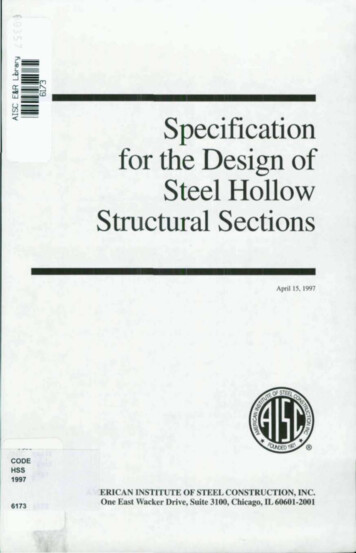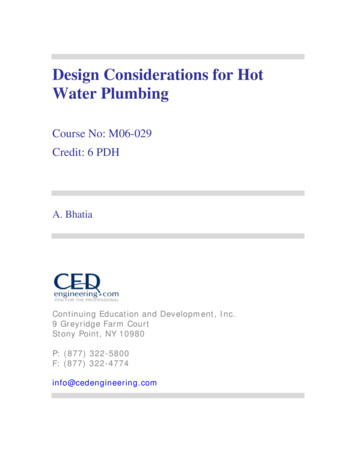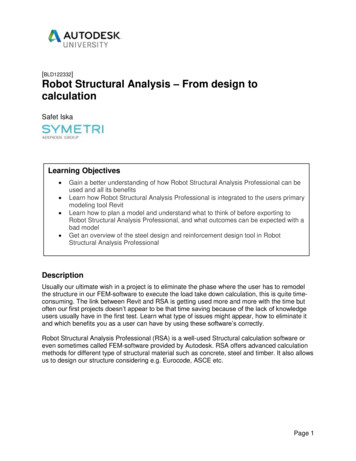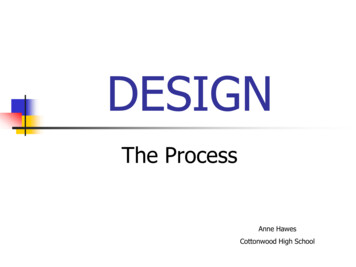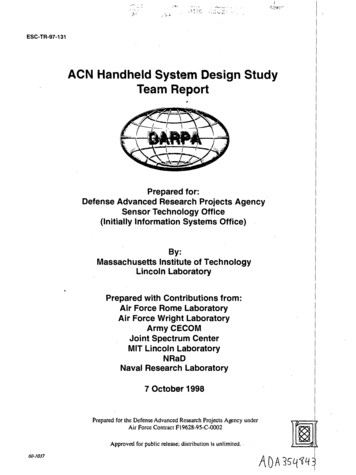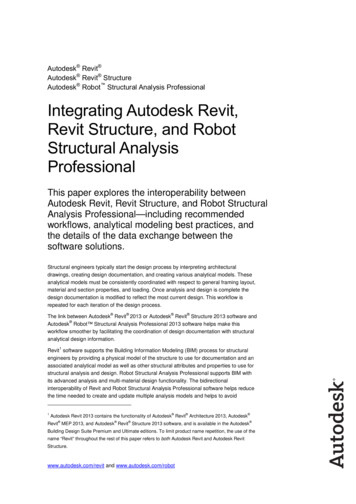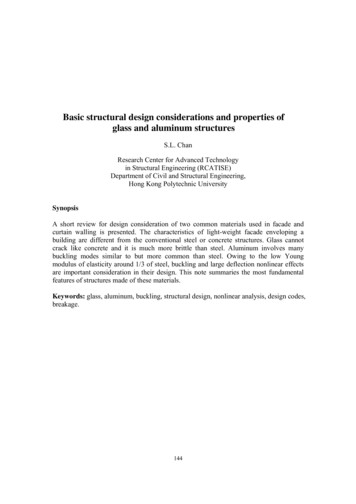
Transcription
Basic structural design considerations and properties ofglass and aluminum structuresS.L. ChanResearch Center for Advanced Technologyin Structural Engineering (RCATISE)Department of Civil and Structural Engineering,Hong Kong Polytechnic UniversitySynopsisA short review for design consideration of two common materials used in facade andcurtain walling is presented. The characteristics of light-weight facade enveloping abuilding are different from the conventional steel or concrete structures. Glass cannotcrack like concrete and it is much more brittle than steel. Aluminum involves manybuckling modes similar to but more common than steel. Owing to the low Youngmodulus of elasticity around 1/3 of steel, buckling and large deflection nonlinear effectsare important consideration in their design. This note summaries the most fundamentalfeatures of structures made of these materials.Keywords: glass, aluminum, buckling, structural design, nonlinear analysis, design codes,breakage.144
IntroductionGlass is a brittle material that is weak in tension because of its non-crystalline molecularstructure. When glass is stressed beyond its strength limit, breakage occurs immediatelywithout warning, unlike steel and aluminum where plastic mechanism can be formed.Stress or moment re-distribution does not occur in glass and local and then consequentialglobal failure is very common in glass. Testing has shown that glass strength is statisticalin nature. Highly stressed and larger stressed area results in a higher probability of failure.Stress vs strain curves for steel and glassDamage of glassduring typhoonpanelsIn spite of the structural shortcoming of glass, its use is unavoidable since they aretransparent and aesthetic and can be tailor-made in shape and color to suit variousarchitectural purposes. We can see that most award-winning projects overseas containheavy glass ingredient.Glass was developed 4000 years ago. In early this century, sheet glass was invented bydrawing glass ribbon vertically out of the molten glass pool. It is distorted because ofvarious viscosity of molten glass. In 1959, float glass was introduced. Glass ribbon ispulled through a tin bath and exit on rollers through an annealing lehr where it is cooled.Rolled glass is made by passing molten glass from a furnace through a series of rolls. It isused for wired glass and patterned glass. However, most common glass used to-day isfloat glass.145
The float glass manufacturing processFor conventional glass panels under heat-treatment for strength improvement, structurallythey can be classified into 3 groups as annealed, heat-strengthened and tempered glass.As glass is a brittle material that stress cannot be re-distributed and failure is assumedonce crack occurs, the failure stress can only be referred as a probability of failure. Thefollowing permissible stress will contain a probability of failure of 0.8% for annealedglass. Also, as a brittle material, glass is failed theoretically by tension only and itscompressive stress is extremely large. The quoted stress is 800 N/mm2 (St. Gobain GlassManufacturer).MTR entrance in JapanDamage of high-rise buildings inHong Kong during visit of typhoonYork146
Stresses in glass used in various national design codesSix national codes have been reviewed. They are the U.S.A., U.K., Australia, Canada,China and Japan. In Japan, they normally use the manufacturer data and the code doesnot provide stress value. In U.K., the Piklkington glass recommendation is used since BSdoes not provide this value. In Canada , they give detailed stress value. Whilst the chartsin U.S.A. are similar to the Canadian one, they are based on the same stress. In Australianand Chinese codes, explicit stress is given. They are tabulated as follows.Typical properties for glassWeight 2500 kg/m3Young’s modulus of elasticity 70 kN/mm2Shear modulus of elasticity (G) 30 kN/mm2Poisson’s ratio 0.22Coefficient of thermal expansion 8.5x10-6/CPermissible deflection (from Australia standard) structural span/60Deflection is very important as complaints are always dueto excessive deflections.Deflection of glass panels under Design pressure(Note the reflection)147
All units below are in N/mm2 : t thickness of glass plateGlass TypeLoad durationLoad .A260 80/100Australian3U.K.4Chinese53 seconds1.203 seconds1.41 for t 634.5 for t 828 for t 1060 seconds1.428 for 5 t 1220 for 15 t 1932505984 for 5 t 1259 for 15 t 191. Canadian General Standards Board (1989), “Structural design of glass for buildings”,CAN/CGSB-12.20-M89. The first one refers to centre stress and the second one toedge stress.2. ASTM (1997), “Standard practice for determining minimum thickness and type ofglass required to resist a specified load, E1300-97.3. Standards Australia (1994), “Glass in buildings – selection and installation”.4. Pilkington Glass (see IStructE, Structural Use of glass in buildings, 1999)5. “Technical Code for Glass Curtain Wall Engineering”, JGJ 102-96, 1996, Beijing,ChinaNOTE: For 0.8% probability of failure in annealed glass, a design factor of 2.5 is used againstthe averaged stress. For 0.1% of failure, the design factor is 5. For sloped glazing, the0.1% failure probability of failure is commonly used. Glass strength is time dependent and these countries use different load duration.(e.g.for a 4-side simply supported glass plate, we have Rt pressure and t is the load duration.)148R1 minutet 115where R is the
Design procedure for thickness of glass panes12345678Determine the shape and size of glass panesAssume boundary conditions along each side of the glass pane (i.e. point-supports,4-side, 3-side or 2 side support)Check the supports for the pane are not deforming too much (i.e. they would notdeform more than span/180). Otherwise strengthen the support or assume a moreconservative boundary conditions.Assess loads and load type. Magnitude and duration of loads are estimated.Compute stress (σ) and deflection (δ) of glass pane by a Nonlinear Finite Elementsoftware and check against maximum stress for glass type and glass deflection(see stress for edge or center locations and for short or long term loads in Tableabove and glass pane deflection should generally be less than structural span/60).Non-linear large deflection theory reflects more accurately the actual behaviour ofa glass pane which behaves nonlinearly.For regular shaped glass panels, design charts are available.Determine glass thicknessDetailing against stress concentration, fabrication, water leakage etc.Check practicality and study safetyThe reason why nonlinear theory predicts less deflection which is closer to experimentalresult is due to the membrane action. As the central point deflects, the material on thefour sides with less deflection restrains the centre movement and thus the deflection isless. The detailed explanation can be found in the paper by So, Lai and Chan (2002).Nonlinear Large Deflection andLinear small deflection theory149
The design charts by linear and non-linear analysesin ASTM (Upper one is linear, lower one is non-linear)150
Linear vs. Non-linear analysisNonlinear analysis is not popular in Hong Kong, because of at least two main reasons asfollows.1.Nonlinear analysis for frames checks P-δ and P- effects and therefore the relatedbuckling modes will not be missed. Linear analysis produces prediction for higherload resistance as it does not consider all possible buckling modes. Unfortunately,many analysts said angrily” Why I have no problem in designing mystructure by my old software and now the structure is detected by anew nonlinear analysis as “unsafe” ? Nonlinear analysis is no good to myproject . until the following happens but it becomes too late”.2.The users are not familiar with nonlinear analysis at all.Table 6.1 in Hong Kong Steel Code (similarly for Table5.1 in Eurocode-3) is required fora full and proper second-order analysis. Make sure software allows users to inputimperfections to Table 6.1 otherwise its output is not to code safety requirements.151
Time dependent nature of glass strengthBreakageThe causes of breakage for glass can be due to (NOT in order of importance): Excessive stress from wind pressure or other loads or insufficient glass thickness Thermal stress due to differential temperature on different parts of the pane(For 330C, the thermal stress is 20.7 N/mm2) Buckling due to large compression (e.g. glass rod and glass fins) Surface or edge damage Deep scratches or gouges Severe weld splatter Windborne missile (i.e. debris impact) Direct contact with metal (e.g. window aluminum frame) and Impurity inclusion like nickel sulfide – VERY COMMON IN H.K. Heat soak test is aQA procedure though not 100% eliminates the contaminated glass, it is believed tobe capable of reducing the breakage by 95% for every hour of heat-soaking.Excessive deflectionDeflection can be a major consideration in glass design for following reasons.AestheticExcessive deflection causes discomfort to the occupants and the outsiders who may feeldiscomfort, fainted or unsecured. This happens in a number of real cases.Structural safetyGlass deflection affects the gaskets and sealant and the supporting frame. If not properlyconsidered, glass-to-metal contact may occur and dislodging of gasket takes place.Excessive deflection causes the sealant to stretch. Possible contact with other buildingmaterial such as those in spandrel. This results in scratching on glass surface.152
There can be sharp object behind a glass panelWatch out !A general requirement for typical glass panes is span/60 suggested in Australian standard.Tempered glassIn order to provide a larger resistance against tension and to achieve the objective thatbreakage will not generate sharp pieces for hurting human, an annealed glass (withoutheat treatment) can be under a heat-treating process. The common process is to first cutthe glass to the desired size and then put inside a furnace and heated uniformly to 6210C.Upon leaving the furnace, the glass is cooled rapidly so that the outer surfaces are undercompression and the inner parts are under tension since the formers cool faster. Thethickness of the compression zone is about 0.2 of the total thickness and the inner tensionzone is about 0.6 of the thickness. The permissible stress is increased 4 times to that ofthe annealed glass (3 times for some countries where the heat treatment temperature isnot that high). The permissible stress is about 50 N/mm2 under unfactored load.153
Stress inside glass and after load applicationThe checking of safety glass was suggested to be carried out by breaking the glass andcounting the number of dices. This is an obstructive test and is not strictly applicable tothe case for tempered glass which may not be a safety glass. A better test will be usingthe refractometer of measuring the surface stress. This is a better method since it is nondestructive, can be used to check installed samples and gives a more scientificmeasurement. The minimum surface stress should not be less than 69N/mm2 (ASTMC1048-85). Tempered glass has no problem in resisting thermal stress due to sunlight.154
One big disadvantage for using tempered glass is the problem of spontaneous breakagedue to impurities nickel sulfide (NiS). NiS is formed when nichel-rich contaminants likenichrome wire and stainless steel, are unavoidably introduced into the glass meltingfurnace and when they are mixed with sulfur, nichel sulfide is formed. They are harmlessin annealed glass since the induced stress cannot break the tensile failure stress of glass,but causes instantaneous breakage when they are located at the tension zone of temperedglass and expand with temperature and time. Heat-soak test is an effective procedure tobreak the glass panels containing NiS in factory rather than after installation. The timeand temperature are important in heat-soaking and their requirement varies from onecountry to another. Buildings Department sets a requirement for the test and furtherimprovement is proposed jointly by the facade group of HKISC and Facade Associationwhich can be downloaded at www.hkisc.org .Spontaneous breakage of tempered glass due to NiSNote the butterfly origin155
Glass panels with opening for bolting are tempered glass in order to cater for stressconcentration.156
Deformed and undeformed shape of a four-point supportedGlass panel by NAF-SHELLStress Contour of the Four-point supported glass plateBy NAF-SHELL157
Heat-strengthened glassThe surface compressive stress is less than tempered and its strength is normally half oftempered glass or twice of annealed glass (see specification in ASTM C1048). Whenbroken, the break pattern is much larger and about the size of an ash-tray. Recently casesof nickel sulfide were also reported and heat-soak test is therefore required. Its cost ishigher since thicker glass panel than tempered glass is needed for the same pressure. Itsstrength is strong enough to resist thermal stress due to sunlight.Annealed glassIt refers to those glass panels without heat treatment. The permissible stress is takenapproximately as 15N/mm2. Sometime we cannot avoid using annealed glass because ofmanufacturing difficult such as the size of glass panels being too large for heat treatment.Due to the small strength, annealed glass is weak in thermal resistance. Partial shadingcauses annealed glass to fail by thermal stress. Very often, glass fins are annealed. Trynot to use anneal glass under direct partly shaded sunlight.Broken glass panel due to thermal stressTinted glassTinted glass or heat-absorbing glass is made by adding colourant to normal clear glass.Light transmittance varies from 14% to 85%, depending on colour and thickness.Because of this nature, the tinted glass is hot and heat-strengthened glass is normally usedin making tinted glass.Coated glassCoated glass is manufactured by placing layers of coating onto the glass surfaces. Thereare two types, the solar control (reflective) and the low emissivity (low-e) types. They aremore related to energy absorption, light transmission and only indirectly affects thestructural strength by changing the thermal stress. Because of this, for colored glass toprevent excessive thermal stress, at least heat-strengthened glass should be used.158
Wired glassWired glass is made by introducing a steel mesh into molten glass during rolling process.It is weak in resisting thermal stress and therefore has a high rate of breakage due tosunlight etc. Polished wired glass is generally used for fire rating since after its breakage,it is stuck to the wire mesh and prevent passage of smoke.Damaged wired glass in center baysLaminated glassThis is a very common form of glass formed by bonding two or more glass panes byinterlayers like pvb or resin. The thickness of this interlayer is normally 0.38mm,0.76mm 1.52mm etc. The major problem for laminated glass is the validity of compositeaction. Can we assume a composite action that, for example, a 8 6mm thick laminatedglass equivalent to 14mm thick glass ? If not, does it behave as two separated panes of 8and 6mm thick ?The actual response for a laminated glass is somewhere between these two extremes. Forshort term load, the behavior is closer to composite assumption whilst for long term load,it behaves as a separated panes because of creeping effect in the interlayer. However, asthe actual response is dependent on the property of the interlayer and it may not be overgeneralized. One method is to use a simple test to measure the deflection of the panelunder a specific load and then compare this deflection calculated by a finite elementprogram. We can then adjust the equivalent thickness in the program to give the samedeflection so that we can determine the equivalent thickness of the laminated glass pane159
and use it for economical and rational design. ASTM C1172 is a relevant standard forfurther information and testing.Laminated glass with full composite actionLaminated glass without any composite actionGlass staircase160
Damaged laminated glass panels at a cover walkwayInsulating glass unitInsulating glass is popular since it insulates sound and heat. They can further be made ofreflective and low-e glass. The common form uses edge construction with a metallicspacer of roll-formed aluminum, stainless steel, coated steel or galvanised steel, sealedwith polysulfide, polyurethane or hot-melt butyl etc. materials. The air-gap between thetwo or more panes of glass provide a good insulation. The filled gas can be hexafluoridewhich is a good sound insulator.ASTM E773 is a relevant standard for checking the quality of insulating glass.161
Chemically strengthened glassIt is seldom used in building industry. The strengthening is carried out by ion-exchangeprocess of submerging glass in a molten salt at temperature below the annealing range ofglass. The larger size potassium ions exchange with the smaller size alkali sodium ions. Itis used for very thin glass in aeronautical industry (t 3mm).GlassFace clearanceBiteEdge clearanceBit and Clearance162
SealantWeather sealant is used for prevention of water penetration. Sealant is used for both thepurpose of holding structural the glass pane and prevention of water leakage. Thestructural strength of common type of structural sealant is 138 kPa and it fails at a strainabout 25%. The sealant bite is calculated from this permissible stress value and thethickness of sealant is determined from the calculated thermal movement (i.e. too thinwill tear the sealant apart during thermal movement). Note that sealant can only takeshort term load and the stress is reduced to 7 kPa for long term load during the creeping.2GlassMullion1TransomAluminum RHSWeathering SealantWeathering SealantGlass plateStructural SealentAluminum capSettingblockSpacerBacker RodMullionTransomGlass plateSection 2Section 1Typical 2-side structural glazing system163
The glass panes should be designed to “float” onto a supporting frame that metal contactand local bending effects are eliminated.164
Common causes of sealant failure(a)Material factorWrong choice of sealant. The usage of unsuitable sealant material for a givensubstrate.(b)Quality of installationPoor workmanship due to lack of skillful labour training.(c)Joint designIncorrect type of joint required with respect to dimensions, location, joint spacingrelated to expected movement, shape and nature of backing material.(d)Sealant dimensionImproper or inadequate sealant dimension in the joint due to incompatibility.(e)Sealant manufacturerError in quality control or poor formulation.(I)Applicator or user faultUnable to communicate with the supplier and manufacturer or lack of sealantknowledge properties.(g) Environmental factorUltra-violet, moisture and temperature.165
Design conceptWhenever possible consider robustness and progressive collapse under unfactored load orwith load factor less than 1 because of probability. One may refer to Code of Practice forStructural Uses of Steel, Hong Kong 2005 for reference of load factors for progressivecollapse.New requirement in non-proportional collapse in Hong Kong Steel Code (2005)166
AluminumMost supporting frames for glass are made of aluminum. Aluminum is corrosionresistant and oxide will be coated for exposed surface. Young’s modulus of aluminum is70,000 N/mm2 which is close to glass. Coefficient of thermal expansion is 23x10-6/0Ctherefore they are good partners when used BS8118)
Design of aluminum can follow the old allowable stress code CP118 or the newlimit state BS8118. The main grades of aluminum used are the Alloy 6063, T-4, T-5 andthe T-6 grade aluminum of same Young’s modulus but with different proof stressrespectively of 110 and 160 N/mm2. Building aluminum is made of 6xxx series and Trepresents the tempering process. T6 has a greater strength than T4 which has a greaterductility. Note that aluminum stress is taken as the 0.2% proof stress since it does nothave a sharp yield point.As for all any glass-supporting framework, transoms and mullions supporting aglass panel should not deflect too much to cause additional bending on the glass. Thedeflection of span/180 or 20mm is generally adopted for this purpose.One important checking for aluminum members used in curtain wall is the lateraltorsional buckling. For beams of open section and bent about the major axis, it will havea tendency to buckle laterally when the laterally unrestrained length is long. This is thecase for mullions or transoms of curtain wall systems, especially the unitized systemwhere units are pre-fabricated. However, one may argue that glass panel provides alateral restraint that the unsupported length is zero. On the other hand, some curtain wallconsultants do not allow the use of glass panels for lateral support. In reality, the beams ispartially supported by glass through flexible sealant in lateral direction and this is asubject of further research and studies. Before this, it is more reasonable to carry out thelateral buckling check.Structural design of aluminum membersLocal plate buckling, lateral-torsional and flexural axial buckling are common causes ofbuckling in aluminum structural members. Conceptually the design is similar to that ofsteel.168
Local buckling checkThe factor β is calculated for two modes, being by plate itself or together with reinforcingribs. In general, it is taken as b/t when under uniform compression in mode 1 or othermodified values. For mode 2, β is hb/t where h is a coefficient depending on the size ofrib and thickness in Figure 4.4 of BS8118. The largest value of β for all plate elementsshould be used for classification of section into plastic, compact, semi-compact andslender section. For plastic and compact sections, plastic modulus can be used for findingthe plastic moment capacity. For semi-compact sections, the elastic modulus should beused for finding the moment capacity. For slender sections, the coefficient kL is used toreduce the thickness. A material factor of 1.2 is commonly used but the load factor islesser than other codes as live load factor is only 1.33 (see Table 3.1 in BS8118).169
Lateral-torsional bucklingTo prevent a beam from buckling in figure below, the slenderness ratio is required as λ L/ry from which the buckling stress ps can be found.170
Column flexural bucklingWhen an aluminum column is under axial force, it may buckle before the stress reachingthe design strength. The checking is carried out by finding of slenderness ratio L/r andthen ps as follows.Buckling stress ps in columnsTorsional bucklingFor short thin-walled aluminum under compression, the member may buckle torsionallyby twisting. This buckling mode is quite uncommon as aluminium members are normallyused as beams in curtain walls and reference should be made to BS8188 for details.171
ConclusionsThe design method and concept for glass and aluminium structures is reviewed. As thecost of façade occupies a high proportion of the total construction cost, the design ofglass and aluminium requires special consideration as the linear theory of analysis anddesign applicable to design of concrete structures is not valid in many cases. The use ofnon-linear analysis not only leads to a safer design, but also to a more economicalsolution as no critical members will be under-designed and redundant members overdesigned. Also the nonlinear larger deflection theory utilizes the membrane action thatleads to a more accurate and economical prediction of deflection in glass panels.AcknowledgementThis applied research studies is a project in the Research Centre of Advanced Technologyin Structural Engineering (RCATISE) of the Civil and Structural Engineering Departmentof the Hong Kong Polytechnic University.ReferencesASTM E1300, standard practice for determining load resistance for glass buildings, 2002.BS8188, Structural use of aluminium, British Standard Institute, Part 1, 1991.Code of practice for the structural use of steel, Hong Kong, 2005, Buildings Department.Structural use of glass in buildings, The Institution of Structural Engineers, 1999.So, A.K.W., Lai, B.S.L. and Chan, S.L., “Economical design of glass and aluminumpanels by the large deflection theory”, HKIE Transaction, vol.9, issue3, December 2002.172
Keywords: glass, aluminum, buckling, structural design, nonlinear analysis, design codes, breakage. 145 Introduction Glass is a brittle material that is weak in tension because of its non-crystalline molecular structure. When glass is stressed beyond its strength limit, breakage occurs immediately

